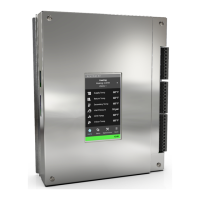Term Definition
be operated for a period of time after the call for heat has ended. This feature takes the
heat left-over in the heat exchanger and nearby boiler piping after the burner has turned
off and pumps it into the load. A good example of this is the indirect water heater DHW
load. After the tank has reached its target temperature, the boiler shuts down, but
allows the load pump to operate for a period of time to transfer heat that is stored in the
boiler’s heat exchanger into the hot water tank. You can adjust this feature in seconds
from 0 to 900 (15 min). If the load has zone valves that close off the flow to the load as
the boiler shuts down, this can be set to 0 sec. You can set each load independently to
provide maximum flexibility.
Ramp Speed How fast the boiler tries to raise the water temperature flowing through the heat
emitters. With a fin tube baseboard radiator, you may want the water temperature to
rise quickly to provide heat as quickly as possible. This type of heat emitter has very
little mass, so it can heat up quickly. When the call for heat is removed, it cools down
quickly. Generally this requires a higher (faster) ramp speed. A radiant floor, on the
other hand, has significant mass, and therefore takes a long time to heat up. When the
call for heat is removed, the floor is still warm and continues to add heat to the space
for a significant period of time. If the indoor temperature overshoots the desired indoor
temperature, we recommend reducing the Ramp Speed value. Generally this requires
a lower (slower) ramp speed. You can manually set the Ramp Speed by choosing a
value from 1 to 10. A setting of 1 will raise the water temperature very slowly and 10
will raise the water temperature very quickly.
Rotation
Rotation monitors the boilers on the network for a difference of more than 48 hours in
burner on time. If a boiler is currently firing, which has 48 hours or more of burner on
time than a currently idle boiler, the active master will tell the idle boiler to fire up.
Once the master detects that the rotated in boiler is in Heating mode, and has finished
its post ignition hold, it will tell the rotated out boiler to shut down. If the rotated in boiler
is in Error, Circulating, or does not complete its post ignition hold within 2 minutes, the
rotation will be declared a failure and the rotated out boiler will continue firing as before.
Rotation balances the amount of time each boiler spends firing. If a run time difference
of more than 48 hours is detected between the currently firing boiler with the most run
time and the idle boiler with the least run time, the running boiler will be shut down and
the idle boiler will be fired up.
Semi-
autonomous
mode
Involves a remote analogue signal to the master boiler’s External Control terminals.
This signal corresponds to a target set-point temperature, with the range scaled
according to the programmed min-max temperatures. IBC’s multi-boiler heat regulation
algorithm still determines which boiler fires, throttle levels etc., but to an externally
determined operating temperature. Call-for-heat to the Master can be conveyed via a
2.1+ VDC signal on the External Control terminal, or via a dry contact boiler enable
with the 0-10VDC input for target temperature.
Short Cycling A boiler’s burner turns on and off frequently. This leads to shorter component life,
reduced efficiency, and higher emissions. A cycle on/off time typically should be 10
minutes or longer.

